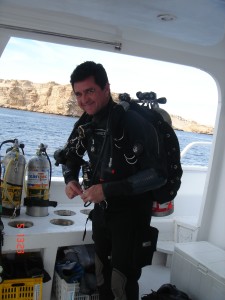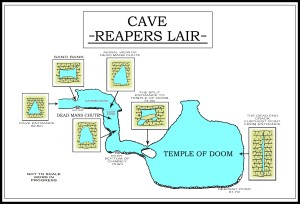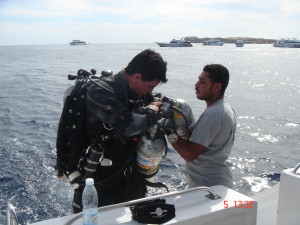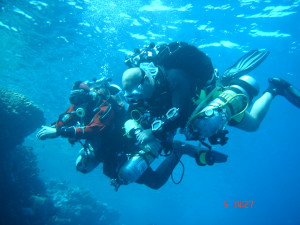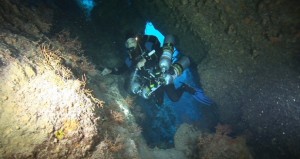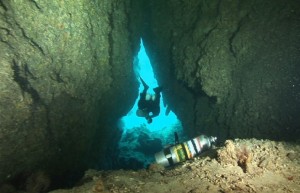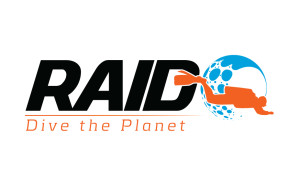News
Paul Toomer and the Temple of Doom
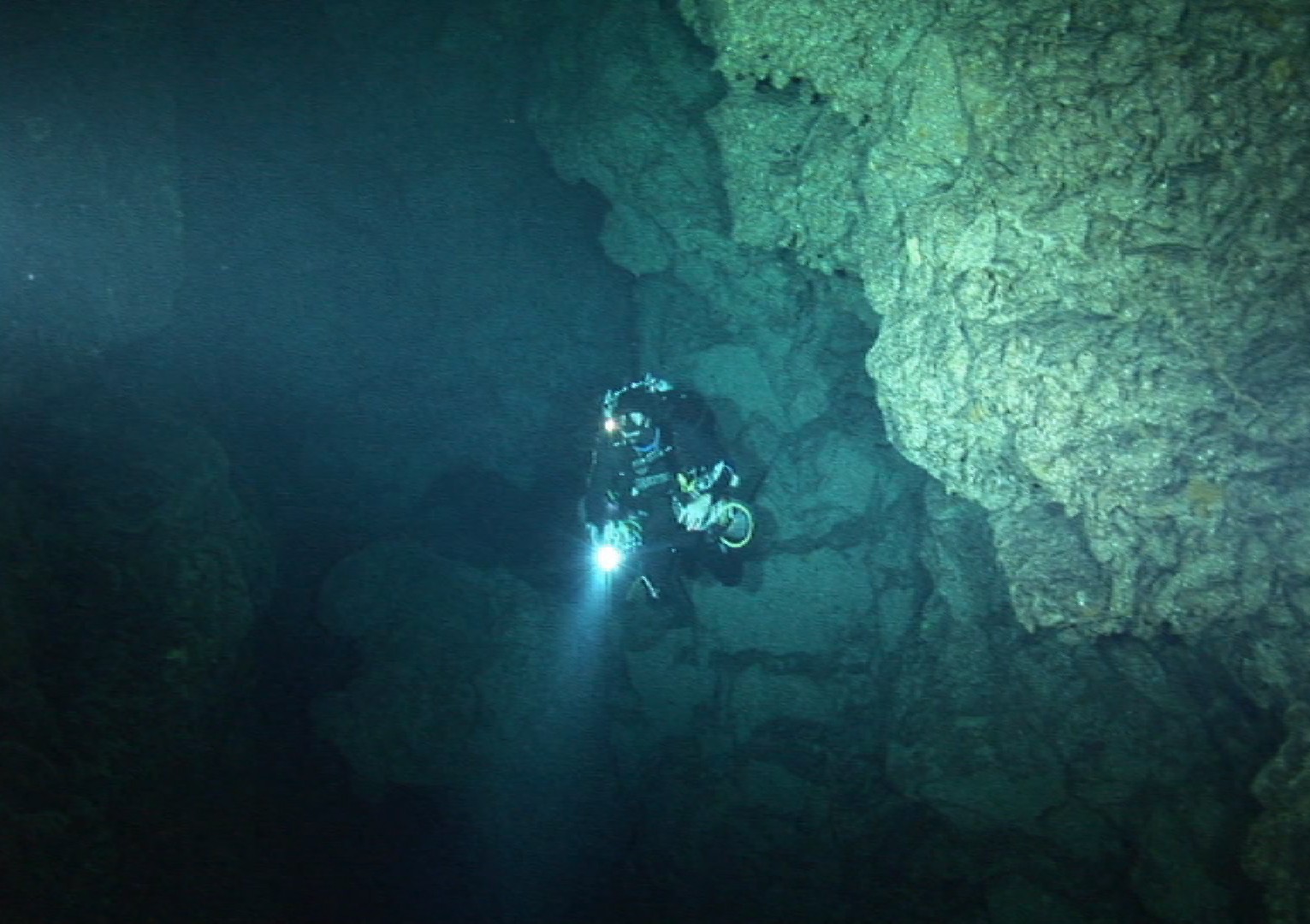
As with any Tech dive, all discussions leading to the actual dive start in a pub somewhere. And this dive was no exception.
I was teaching an IDC (Instructor Development Course) in Sharm and my off day (when my candidates would be at the IE) was due in a few days time. My friends Doozer (Paul Close), Leigh Cunningham, Jim Dowling and Jimmy Jewel had invited me to Papa’s Bar for a quiet drink when it was suggested that I use my off time to go on the best tech dive in Sharm, the newly discovered caves at Ras Mohammed.
I hadn’t been cave diving for quite some time and the thought of a deep cave with a limited amount of penetration in crystal clear water made my heart skip a beat. This dive would put everything I’d learnt throughout my entire diving life to the test.
As with any properly planned dive, we decided to do the shallower cave and get comfortable there before progressing on to the deeper ones. By shallow, I mean entering the cave at 63m! My God, when did that qualify as shallow?
I’ve got to say that us divers don’t half big up our dive sites and when Doozer said the system was called the “Reaper’s Lair” I nearly died laughing!
“Take a guess what the deep portion is called?” Jim asked?
“Let me guess, something like Satan’s Scrotum?”
“No, no, nothing like that. It’s called the TEMPLE of DOOM!”
Now anyone who knows me can only imagine the huge grin on my face at this point.
So it was on. Reaper’s Lair in two days time.
First port of call was my mates Toby Truelove (yes that is his name) and Ricky Browne, both tech instructors for Technical Red Sea, an awesome Tech Company in Sharm.
Because I was on an IDC and had no tech kit, it was up to Toby and Ricky to kit me up with the state of the art kit this dive would need. And state of the art it was. An identical rig to my own was provided in about 5 minutes. Awesome service.
Then Doozer and I planned the dive and all contingencies and Chad Clark”e” from Ocean Tec provided all the gasses we required.
And so the day came.
There were three dive teams and we were all met by Chad at Travco Jetty who double checked that his team had given us the perfect mixes for our dives. Then it was out to RasMo.
Upon arrival, we put Jim and Jimmy in the water first. Their task was the most crucial to the day. Find the entrance and put up a marker buoy for all the guys that would be penetrating the caves. Without this marker, too much time would be lost and a penetration would become impossible. After about twenty minutes a beautiful red SMB (Surface Marker Buoy) hit the surface.
Then Leigh and his buddy hit the water.
Now it was time for me and Doozer to get ready. Man I was focussed, and before I knew it, we had done our predive planning (gear and gas matching, profile and limitations), were dropped next to the SMB and were on our way to the entrance.
Oh my God. What a wonderful site lay before me. I entered first following the permanent line that links the cave to the open ocean. 63m. My light illuminated a beautiful chamber that disappeared into the distance. It’s quite a silty cave so we had to keep ourselves within contact of the line but high enough off the bottom so as not to disturb the fine sand that lay on the coral floor.
We passed a warning sign advising non-trained cave divers to go no further, and then I noticed the line drop into the floor of the cave. We were leaving the cavern (light) zone. This tickled me – a cavern zone at 70m! I followed the line through a beautiful arch made by falling debris and entered the Temple of Doom. My computer was now going through 80m and approaching our max planned depth of 90m.
I couldn’t believe I was here. It was like being on the moon. Doozer and I exchanged OK signals, gas and time were good. We then began to explore this wonderful chamber. Breathtaking is the only word that isn’t an expletive that can convey how beautiful it was in there. As we moved into the back of the chamber there was another small tunnel heading up to God knows where. I pushed my light into the tunnel to see if I could enter it but with all the kit I had on it was impossible.
Before I knew it, I was nearing my maximum time for the dive and we had reached our turn time. The exit was in fact the most exciting part of the dive; watching Doozer move through the arch and seeing what both of our lights displayed was wonderful – fissures, crags and old coral structures everywhere.
Entering the cavern zone we were able to chill for a few moments and take in the glory of the light coming through the entrance. For me, looking through this window is always one of the highlights to any cave dive.
Then it was up time and we swam into the blue to begin our decompression schedule to the surface.
What a day and what a wonderful dive. One I shall definitely revisit.
Next time I am planning to do several dives which will culminate with the deep cave system, which starts at about 90m and goes to around 130m or so.
I would like to thank everyone mentioned in this article for making this dive possible.
I must stress that this is a serious dive, but with the right training and experience diving these places becomes ever more possible.
Paul is the Director of Training at RAID. To find out more about the courses that RAID offers, visit www.diveraid.com.
Blogs
Northern Red Sea Reefs and Wrecks Trip Report, Part 3: The Mighty Thistlegorm

Jake Davies boards Ghazala Explorer for an unforgettable Red Sea diving experience…
Overnight, the wind picked up, making the planned morning dive a bit bumpy on the Zodiacs to the drop point on Thomas Reef. There, we would dive along the reef before descending through the canyon and then passing under the arch before ascending the wall with a gentle drift. The site provided great encounters with more pelagic species, including shoals of large barracuda, tuna, and bigeye trevally.
Once back on the boat, it was time to get everything tied down again as we would head back south. This time, with the wind behind us, heading to Ras Mohammed to dive Jackfish Alley for another great gentle drift wall dive before then heading up the coast towards the Gulf of Suez to moor up at the wreck of the Thistlegorm. This being the highlight wreck dive of the trip and for many onboard, including myself, it was the first time diving this iconic wreck. I had heard so much about the wreck from friends, and globally, this is a must on any diver’s list. Fortunately for us, there was only one other boat at the site, which was a rarity. A great briefing was delivered by Ahmed, who provided a detailed background about the wreck’s history along with all the required safety information as the currents and visibility at the site can be variable.

Kitting up, there was a lot of excitement on deck before entering the water and heading down the shoreline. Descending to the wreck, there was a light northerly current which reduced the visibility, making it feel more like the conditions that can be found off the Welsh coast. At 10m from the bottom, the outline of the wreck appeared as we reached the area of the wreck which had been bombed, as our mooring line was attached to part of the propeller shaft. Arriving on deck, instantly everywhere you looked there were many of the supplies which the ship was carrying, including Bren Carrier tanks and projectiles that instantly stood out.

We headed around the exterior, taking a look at the large propeller and guns mounted on deck before entering the wreck on the port side to take a look in the holds. It was incredible to see all the trucks, Norton 16H, and BSA motorcycles still perfectly stacked within, providing a real snapshot in time.

Overall, we had four dives on the Thistlegorm, where for all of the dives we were the only group in the water, and at times, there were just three of us on the whole wreck, which made it even more special, especially knowing that most days the wreck has hundreds of divers. Along with the history of the wreck, there was plenty of marine life on the wreck and around, from big green turtles to batfish, along with shoals of mackerel being hunted by trevally. Some unforgettable dives.

The final leg of the trip saw us cross back over the Suez Canal to the Gobal Islands where we planned to stay the night and do three dives at the Dolphin House for the potential of sharing the dive with dolphins. The site, which included a channel that was teeming with reef fish, especially large numbers of goatfish that swam in large shoals along the edge of the reef. These were nice relaxing dives to end the week. Unfortunately, the dolphins didn’t show up, which was okay as like all marine life they are difficult to predict and you can’t guarantee what’s going to be seen. With the last dive complete, we headed back to port for the final night where it was time to clean all the kit and pack before the departure flight the next day.

The whole week from start to finish on Ghazala Explorer was amazing; the boat had all the facilities you need for a comfortable week aboard. The crew were always there to help throughout the day and the chefs providing top quality food which was required after every dive. The itinerary providing some of the best diving with a nice mixture of wreck and reef dives. I would recommend the trip to anyone, whether it’s your first Red Sea liveaboard in the Red Sea or you’re revisiting. Hopefully, it’s not too long before I head back to explore more of the Red Sea onboard Ghazala Explorer.

To find out more about the Northern Red Sea reef and wrecks itineraries aboard Ghazala Explorer, or to book, contact Scuba Travel now:
Email: dive@scubatravel.com
Tel: +44 (0)1483 411590
Photos: Jake Davies / Avalon.Red
Blogs
Northern Red Sea Reefs and Wrecks Trip Report, Part 2: Wall to Wall Wrecks

Jake Davies boards Ghazala Explorer for an unforgettable Red Sea diving experience…
The second day’s diving was a day full of wreck diving at Abu Nuhas, which included the Chrisoula K, Carnatic, and Ghiannis D. The first dive of the day was onto the Chrisoula K, also known as the wreck of tiles. The 98m vessel remains largely intact where she was loaded with tiles which can be seen throughout the hold. The stern sits at 26m and the bow just below the surface. One of the highlights of the wreck is heading inside and seeing the workroom where the machinery used for cutting the tiles are perfectly intact. The bow provided some relaxing scenery as the bright sunlight highlighted the colours of the soft coral reef and the many reef fish.

Following breakfast, we then headed to the next wreck, which was the Carnatic. The Carnatic is an 89.9m sail steamer vessel that was built in Britain back in 1862. She ran aground on the reef back in 1869 and remains at 27m. At the time, she was carrying a range of items, including 40,000 sterling in gold. An impressive wreck where much of the superstructure remains, and the two large masts lay on the seafloor. The wooden ribs of the hull provide structures for lots of soft corals, and into the stern section, the light beams through, bouncing off the large shoals of glass fish that can be found using the structure as shelter from the larger predators that are found outside of the wreck.

The final wreck at Abu Nuhas was the Ghiannis D, originally called ‘Shoyo Maru,’ which was 99.5m long and built in Japan back in 1969 before becoming a Greek-registered cargo ship in 1980. The ship then ran aground on the reef on April 19th, 1983, and now sits at the bottom at a depth of 27m. Heading down the line, the stern of the ship remains in good condition compared to the rest of the hull. The highlight of the wreck, though, is heading into the stern section and down the flights of stairs to enter the engine room, which remains in good condition and is definitely worth exploring. After exploring the interior section of the ship, we then headed over to see the rest of the superstructure, where it’s particularly interesting to see the large table corals that have grown at the bow relatively quickly considering the date the ship sank. After surfacing and enjoying some afternoon snacks, we made sure everything was strapped down and secured as we would be heading north and crossing the Gulf of Suez, where the winds were still creating plenty of chop.

The next morning, it was a short hop to Ras Mohammed Nature Reserve for the next couple of days of diving. The 6am wake-up call came along with the briefing for the first site we would be diving, which was Shark & Yolanda. The low current conditions allowed us to start the dive at Anemone City, where we would drift along the steep, coral-filled wall. These dives involved drifts, as mooring in Ras Mohammed wasn’t allowed to protect the reefs. As a dive site, Shark & Yolanda is well-known and historically had a lot of sharks, but unfortunately not so many in recent years, especially not so early in the season. However, there was always a chance when looking out into the blue.

The gentle drift took us along the steep walls of the site, with plenty of anemone fish to be seen and a huge variety of corals. It wasn’t long into the dive before we were accompanied by a hawksbill turtle, who drifted with us between the two atolls before parting ways. Between the two reefs, the shallow patch with parts of coral heads surrounded by sand provided the chance to see a few blue-spotted stingrays that were mainly resting underneath the corals and are always a pleasure to see. With this being the morning dive, the early sunlight lit up the walls, providing tranquil moments. Looking out into the blue, there was very little to be seen, but a small shoal of batfish shimmering underneath the sunlight was a moment to capture as we watched them swim by as they watched us.

Towards the end of the dive, we stopped at the wreck of the Jolanda where the seafloor was scattered with toilets from the containers it was carrying. This provided a unique site to make a safety stop, which was also accompanied by a large barracuda slowly swimming by, along with a hawksbill turtle calmly swimming over the reef as the sun rays danced in the distance.
For the next dive, we headed north to the Strait of Tiran to explore the reefs situated between Tiran Island and Sharm El Sheik, which were named after the British divers who had found them. We started on Jackson before heading to Gordons Reef, where we also did the night dive. All the atolls at these sites provided stunning, bustling coral reefs close to the surface and steep walls to swim along, which always provided the opportunity to keep an eye out for some of the larger species that can be seen in the blue. Midwater around Jackson Reef was filled with red-toothed triggerfish and shoals of banner fish, which at times were so dense that you couldn’t see into the blue. Moments went by peacefully as we enjoyed the slow drift above the reef, watching these shoals swim around under the mid-afternoon sun.

The night dive at Gordon’s Reef was mainly among the stacks of corals surrounded by sand, which was great to explore under the darkness. After some time circling the corals, we came across what we were really hoping to find, and that was an octopus hunting on the reef. We spent the majority of the dive just watching it crawl among the reef, blending into its changing surroundings through changes in colour and skin texture. It’s always so fascinating and captivating to watch these incredibly intelligent animals, in awe of their ability to carry out these physical changes to perfectly blend into the reef. Before we knew it, it was time to head back to the boat to enjoy a well-deserved tasty dinner prepared by the talented chefs onboard.
Check in for the 3rd and final part of this series from Jake tomorrow!
To find out more about the Northern Red Sea reef and wrecks itineraries aboard Ghazala Explorer, or to book, contact Scuba Travel now:
Email: dive@scubatravel.com
Tel: +44 (0)1483 411590
Photos: Jake Davies / Avalon.Red
-

 News3 months ago
News3 months agoHone your underwater photography skills with Alphamarine Photography at Red Sea Diving Safari in March
-

 News3 months ago
News3 months agoCapturing Critters in Lembeh Underwater Photography Workshop 2024: Event Roundup
-

 Marine Life & Conservation Blogs2 months ago
Marine Life & Conservation Blogs2 months agoCreature Feature: Swell Sharks
-

 Blogs2 months ago
Blogs2 months agoMurex Resorts: Passport to Paradise!
-

 Blogs2 months ago
Blogs2 months agoDiver Discovering Whale Skeletons Beneath Ice Judged World’s Best Underwater Photograph
-

 Gear Reviews3 months ago
Gear Reviews3 months agoGear Review: Oceanic+ Dive Housing for iPhone
-

 Marine Life & Conservation2 months ago
Marine Life & Conservation2 months agoSave the Manatee Club launches brand new webcams at Silver Springs State Park, Florida
-

 News3 months ago
News3 months agoWorld’s Best Underwater Photographers Unveil Breathtaking Images at World Shootout 2023


